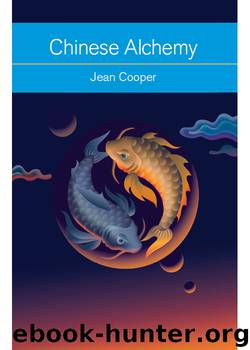Chinese Alchemy by Cooper Jean;

Author:Cooper, Jean;
Language: eng
Format: epub
ISBN: 4516872
Publisher: Red Wheel Weiser
– 10 –
THE FIVE ELEMENTS
In an early treatise, written about 135 BC, we read:
Earth has its place in the centre and is the rich soil of Heaven. Earth is Heaven's thighs and arms, its virtue so prolific, so lovely to view, that it cannot be told at one time of telling. In fact Earth is what brings these Five Elements and Four Seasons all together. Metal, wood, water and fire each have their offices, yet if they did not rely on Earth in the centre, they would all collapse. In similar fashion there is a reliance of sourness, saltiness, bitterness and sweetness. Without that basic tastiness the others could not achieve ‘flavour.’ The sweet [the edible] is the root of the Five Elements, and its ch'i is their unifying principle, just as the existence of sweetness among the five tastes cannot but make them what they are.
This shows clearly the difference between the doctrine of the Elements in the East and West. The Earth, which is only one of the four elements in western tradition, is, in China, the central and most important on which all the others depend and from which they derive their vital energy (ch'i). The western teaching, following Aristotle and Empedocles, has four elements: earth, air, fire and water. For Aristotle, they proceed from the prima materia, a basic matter on which all forms can be imposed or imprinted, though itself remaining changeless. Matter and form interact to produce the four elements, which give rise to all things by simply changing the proportions of the elements, so that any one substance can be changed into another by varying the contents of the different parts, provided the right proportions are discovered. All things are, therefore, interchangeable: they are different forms of the same matter. This is the very essence of alchemical belief and work: that transmutation from one state to another is possible, that the principle of transmutation is inherent in Nature, so that the lead of base metal can be transformed into the purity of gold and the lead of the human situation transmuted into the gold of divine perfection. Or, as Marco Pallis phrases it: ‘It implies the possibility of converting whatever is base and polluted into something pure and noble.’ So, then, the Five Elements were not only concerned with material and seasonal changes but with the understanding of inner changes and alchemical transmutation in the individual.
There is, however, a suggestion of the fifth element in Aristotle's ether; while in the Hermetic and Rosicrucian teachings the four elements are represented by the cross, with the point of intersection, the centre, as the quintessence. A. K. Coomaraswamy draws attention to the idea of the four elements as demonstrating one of the many associations between alchemy, masonry and architecture. The four elements are symbolized by the four cornerstones, or foundation stones of a building, ‘since it is upon them that the whole corporeal world, represented by the shape of the square, is constructed . . .
Download
This site does not store any files on its server. We only index and link to content provided by other sites. Please contact the content providers to delete copyright contents if any and email us, we'll remove relevant links or contents immediately.
Tools of Titans by Timothy Ferriss(7815)
Crystal Healing for Women by Mariah K. Lyons(7711)
The Witchcraft of Salem Village by Shirley Jackson(7037)
Inner Engineering: A Yogi's Guide to Joy by Sadhguru(6442)
The Four Agreements by Don Miguel Ruiz(6319)
The Power of Now: A Guide to Spiritual Enlightenment by Eckhart Tolle(5333)
Secrets of Antigravity Propulsion: Tesla, UFOs, and Classified Aerospace Technology by Ph.D. Paul A. Laviolette(4995)
The Wisdom of Sundays by Oprah Winfrey(4950)
Room 212 by Kate Stewart(4739)
Pale Blue Dot by Carl Sagan(4618)
Fear by Osho(4495)
The David Icke Guide to the Global Conspiracy (and how to end it) by David Icke(4381)
Rising Strong by Brene Brown(4192)
Animal Frequency by Melissa Alvarez(4154)
How to Change Your Mind by Michael Pollan(4113)
Sigil Witchery by Laura Tempest Zakroff(4029)
Real Magic by Dean Radin PhD(3923)
The Art of Happiness by The Dalai Lama(3847)
Man and His Symbols by Carl Gustav Jung(3845)
